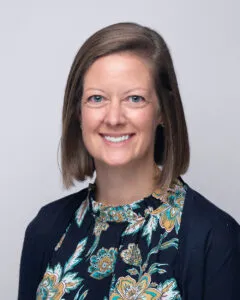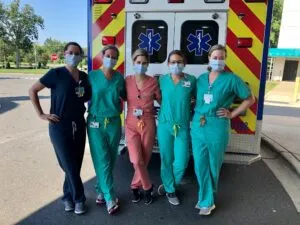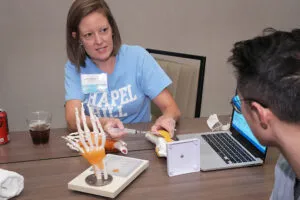A Day in the Life of a Physician Assistant

Anna Huneycutt doesn’t hesitate when asked to describe a typical day for an experienced physician assistant in a hospital emergency department.
“There definitely is no such thing as a typical day,” she says without missing a beat.
In fact, the variety and unpredictability of each day’s tasks, patients, experiences and health care challenges are just some of the factors that lured her to the ED and keeps her tethered there.
Whether patients arrive at the ED on foot, on crutches, leaning on a coworker or family member, or in a rush on an ambulance stretcher, she and her team are always poised to provide care.
“It can be stressful and anxiety-inducing walking into the unknown, but you just have to go with the flow,” says Anna, a certified physician assistant (PA-C) who has worked for ApolloMD at a community hospital ED in Monroe, NC for 11 years.
“I think that’s what drives those of us who work in the ED — we have an innate ability to flex, bend and roll with the punches. You have to be prepared for anything, hit the ground running, and don’t stop until your shift is over,” she explains. “Once you’re OK with the fact that there is no such thing as a standard day, it makes your life less stressful and boosts your confidence in your ability to deal with anything.”
Every day, something different

Anna (second from the left) with her ED
team at Atrium Health Union.
No two days are alike in the ED, but Anna says that common patterns tend to emerge.
Monday mornings, for example, often involve a waiting room of patients with a variety of complaints—from those who might need emergency care for chest pain, shortness of breath or weakness to those who need evaluation after a weekend accident, symptom flare-up, or a simple procedure for a minor ailment. They’re evaluated, treated, and ultimately admitted or discharged home with follow-up instructions.
Other days can range from quiet to nice-and-steady to chaotically overwhelming. According to Definitive Software, which specializes in commercial health care intelligence, common non-COVID diagnoses in the ED in 2021 were chest pain, shortness of breath, abdominal pain, blood pressure problems, headache, fever, nausea, cough, urinary tract infection, upper respiratory infection, head injury, fainting/collapse, weakness, diarrhea, and mental confusion.
Anna recalls a recent day when her primary goal was to meet and train a new employee on what she hoped would be a “routine” day.
Instead, they walked into the bustling ED, where 34 patients had already filled the unit’s treatment beds and another 20 with varying needs and symptoms were waiting to be seen by the ED team.

Anna teaching at the 2022 ApolloMD
Leadership Conference.
“Every nook and cranny had a patient waiting to be seen or for their treatment to be completed,” says Anna, noting that ED backlogs occur nationwide as hospitals struggle with a nursing shortage. ED patients waiting to be admitted sometimes have to be cared for in the ED until an inpatient hospital bed becomes available. While patients wait, APCs, physicians and other team members must remain accessible, approachable, and able to help in any capacity or area of the ED.
One patient on that busy day, for example, was an orthopedic patient whose artificial hip had become dislocated. Anna joined two other team members to manipulate the hip into the socket.
“In partnership with my supervising physician, the patient was placed under deep sedation, and we literally stood on the bed and adjusted her hip back into place,” she recalls. “The orthopedic surgeon was surprised and impressed.”
Key traits: flexibility and a caring mindset
That kind of flexibility and broad-based knowledge is a necessary trait for anyone who works in a hospital ED.
“As a PA in the emergency department, you have to think on your feet and provide care wherever and whenever you need to help,” she explains.
“I sometimes describe APCs as the Swiss army knives in the ED. Nurses and other staff will often say, ‘Hey, go talk to Anna, she’ll have a solution’ or ‘that’s a question for Anna’ or ‘Anna, can you come and see my critically ill patient? I could use some help while we wait for admission.’ We see patients in triage, and if the team needs help in the waiting room, we’ll go out into the waiting room and see if we can evaluate a particular patient or place an order for medications they need.”
ApolloMD provides an award-winning APC Advancement Program to new hires and employees to keep their skills sharp and knowledge current.
And the most memorable patients?
“They’re the patients who are here on the worst day of their life,” Anna says without missing a beat. “You’re able to go in there, provide a sense of calmness, reassure them that they’re in good hands, and offer them empathy.”
“I remember the first patient I diagnosed with cancer…I tried to make him more comfortable during his ED stay, address his anxiety, and answer questions,” she recalls. “Sometimes, you have to be honest with patients and tell them you don’t know the answer, but that you will get them to other professionals who can.”
Considering an ED career?
She advises anyone considering a career in emergency medicine to research the profession and understand what it involves…professionally and personally.
“It helps to have a solid understanding of the schedule that emergency medicine requires,” she explains. “It is a 24/7/365 gig. We work nights, holidays, weekends, and oftentimes we’re away from our families. Yes, it can be glamorous and exciting, and everybody wants to do procedures, but it’s not that all the time. You really have to know what you’re getting into.”
One of the most affirming benefits: ED professionals are respected, and can build reputations for being reliable, competent, and accessible.
“In the ED, we internalize our work and take a lot of pride in what we do,” she says. “Patients put their trust in you in the ED, and that’s a huge responsibility to have. And if you’re able to put out 70 fires during the day, you come home and say to yourself, ‘Wow, I really accomplished something today.’ It’s very rewarding work.”
That is particularly true at ApolloMD, which specializes in emergency care at its partner hospitals.
“Our local team is one of the reasons that I love my job so much,” says Anna. “Our medical director, the providers we work alongside, the members of our corporate and executive team – there’s just a level of support for the advanced practice clinicians that is unmatched.”
Find current openings for ED professionals at ApolloMD.






